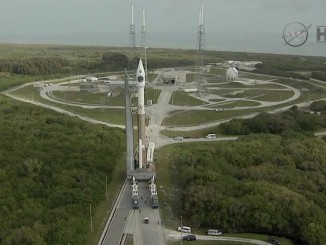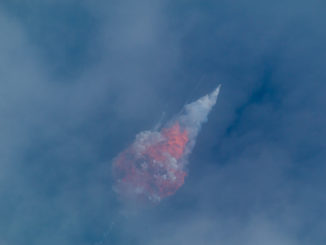
NASA’s Mars 2020 Perseverance mission resumed normal operations Friday after cold temperatures forced the spacecraft into safe mode soon after a successful launch from Cape Canaveral.
“With safe mode exit, the team is getting down to the business of interplanetary cruise,” said Matt Wallace, the Mars 2020 mission’s deputy project manager at NASA’s Jet Propulsion Laboratory.
“Next stop, Jezero Crater,” he added, referring to the Perseverance rover’s landing site on Mars.
The $2.7 billion Mars 2020 mission lifted off from Cape Canaveral aboard a United Launch Atlas 5 rocket at 7:50 a.m. EDT (1150 GMT) Thursday. Less than an hour later, the rocket’s Centaur upper stage deployed the Mars 2020 spacecraft right on target on a trajectory to break free of Earth’s gravitational grasp and head into the solar system.
But the spacecraft, containing NASA’s Perseverance rover, detected colder temperatures than expected as it flew in Earth’s shadow, a phase of the mission known as an eclipse. After flying back into sunlight, the spacecraft powered up its radio transmitter and began sending signals to ground teams through NASA’s Deep Space Network.
The DSN antennas are tuned to listen for faint radio signals from spacecraft in distant parts of the solar system, and the powerful transmissions from the Mars 2020 spacecraft — while it was still near Earth — saturated the network’s receivers. That has happened on previous missions, NASA officials said, and ground teams soon resolved the minor issue to establish a stable lock on Mars 2020.
Separately, the Mars 2020 spacecraft autonomously went into a standby operating state known as safe mode soon after deploying from the Atlas 5 rocket. Wallace said Thursday the temperature on part of the spacecraft dipped below a preset limit, triggering the safe mode.

In safe mode, the spacecraft reverts to a basic operating mode and turns of all but essential systems until it receives new commands from ground controllers, according to NASA.
NASA said in a statement after Thursday’s launch that the temperature disparity was in the Mars 2020 spacecraft’s liquid freon coolant loop, which dissipates heat from the center of the spacecraft through radiators on the carrier module carrying the rover to Mars.
“Chances are we may have just tightened down on that limit a little too much, and it triggered a safe mode,” Wallace told Spaceflight Now.
NASA’s Curiosity rover, upon which Perseverance was designed, did not enter the Earth’s shadow after its launch in 2011. So engineers relied on analytical modeling to predict the temperatures during the eclipse.
“We set the limits for the temperature differential conservatively tight for triggering a safe mode,” Wallace said. “The philosophy is that it is far better to trigger a safe mode event when not required, than miss one that is.”
In the coming weeks, ground teams at JPL will begin activating the spacecraft’s systems and instruments for post-launch checkouts. The testing will ensure all systems are ready for the mission’s make-or-break landing attempt on Mars planned for Feb. 18, 2021.
The one-ton Perseverance rover carries seven instruments to explore the geology and climate at the mission’s landing site inside Jezero Crater, an impact basin that once contained a lake roughly the size of Lake Tahoe. There is also evidence that an ancient river flowed into the lake more than 3.5 billion years ago, leaving behind a dried-up river delta, where sedimentary rock deposits may contains signs of past life.
The six-wheeled robot will drive across the delta, and scientists will use data from the rover to select rocks for the craft’s sample collection drill. The drill will extract core samples for storage inside small tubes carried to Mars aboard the rover.
A future mission will retrieve the sample tubes and return the Martian rock specimens to Earth for detailed analysis.
The Perseverance rover also carries NASA’s Ingenuity helicopter, a tiny rotorcraft that will attempt to become the first vehicle of its kind to fly in the atmosphere of another planet.
Email the author.
Follow Stephen Clark on Twitter: @StephenClark1.



